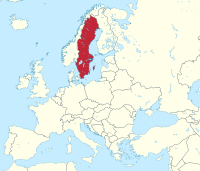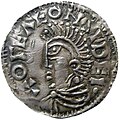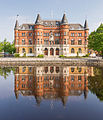Welcome to the Sweden Portal! | |||||||||

|

|

| |
Sweden, formally the Kingdom of Sweden, is a Nordic country located on the Scandinavian Peninsula in Northern Europe. It borders Norway to the west and north, Finland to the east, and is connected to Denmark in the southwest by a bridge–tunnel across the Öresund.
At 450,295 square kilometres (173,860 sq mi), Sweden is the largest Nordic country and the fifth-largest country in Europe. The capital and largest city is Stockholm. Sweden has a population of 10.5 million, and a low population density of 25.5 inhabitants per square kilometre (66/sq mi), with around 87% of Swedes residing in urban areas, which cover 1.5% of the entire land area, in the central and southern half of the country. Nature in Sweden is dominated by forests and many lakes, including some of the largest in Europe. Many long rivers run from the Scandes range, primarily emptying into the northern tributaries of the Baltic Sea. It has an extensive coastline and most of the population lives near a major body of water. With the country ranging from 55°N to 69°N, the climate of Sweden is diverse due to the length of the country.
Germanic peoples have inhabited Sweden since prehistoric times, emerging into history as the Geats (Swedish: Götar) and Swedes (Svear) and constituting the sea peoples known as the Norsemen. A unified Swedish state emerged during the late 10th century. In 1397, Sweden joined Norway and Denmark to form the Scandinavian Kalmar Union, which Sweden left in 1523. When Sweden became involved in the Thirty Years' War on the Protestant side, an expansion of its territories began, forming the Swedish Empire, which remained one of the great powers of Europe until the early 18th century. During this era Sweden controlled much of the Baltic Sea. ( Full article...)
" Breakin' Point" is a song by Swedish band Peter Bjorn and John from their seventh studio album Breakin' Point (2016). It was released on 25 March 2016 through PBJ Musik and Ingrid as the album's second single. Written by the band and produced by Emile Haynie, "Breakin' Point" is a midtempo pop song with lyrics alluding to the protagonist's concerns about expecting a child. It features a whistling intro, which the band were initially hesitant to include as their breakthrough single " Young Folks" (2006) had a similar composition. They eventually decided "Breakin' Point" would represent a fitting tribute as it was conceived near the ten-year anniversary of "Young Folks".
Music critics were generally positive towards "Breakin' Point" and noted its catchiness. Commercially, the single only appeared below the top 50 of the Wallonian Ultratip chart. A remix by Swedish band Miike Snow was also released. The song's accompanying music video was shot in Poland on several locations, including Wolin National Park. It was directed by Danish-Norwegian duo HochR, who took inspiration from the rivers of Hades in the underworld from Greek mythology, particularly the river Styx. ( Full article...)Selected article -
Greta Garbo (born Greta Lovisa Gustafsson; 18 September 1905 – 15 April 1990) was a Swedish-American actress and a premiere star during Hollywood's silent and early golden eras. Regarded as one of the greatest screen actresses of all time, she was known for her melancholic and somber screen persona, her film portrayals of tragic characters, and her subtle and understated performances. In 1999, the American Film Institute ranked Garbo fifth on its list of the greatest female stars of classic Hollywood cinema.
Garbo launched her career with a secondary role in the 1924 Swedish film The Saga of Gösta Berling. Her performance caught the attention of Louis B. Mayer, chief executive of Metro-Goldwyn-Mayer (MGM), who brought her to Hollywood in 1925. She stirred interest with her first American silent film, Torrent (1926). Garbo's performance in Flesh and the Devil (1926), her third movie, made her an international star. In 1928, Garbo starred in A Woman of Affairs, which catapulted her to MGM's highest box-office star, surpassing the long-reigning Lillian Gish. Other well-known Garbo films from the silent era are The Mysterious Lady (1928), The Single Standard (1929), and The Kiss (1929). ( Full article...)Did you know -

- ... that Baggböle manor is built entirely of wood, but made to look like a stone building?
- ... that Solna Church ( click for picture), a round church in Stockholm from the late 12th century, was originally built for defense purposes?
- ... that one of the richest people in the world, Ingvar Kamprad, is Swedish?
General images -
The Battle of Öland was a naval battle between an allied Danish- Dutch fleet and the Swedish navy in the Baltic Sea, off the east coast of Öland on 1 June 1676. The battle was a part of the Scanian War (1675–79) fought for supremacy over the southern Baltic. Sweden was in urgent need of reinforcements for its north German possessions; Denmark sought to ferry an army to Scania in southern Sweden to open a front on Swedish soil.
Just as the battle began, the Swedish flagship Kronan sank, taking with it almost the entire crew, including the Admiral of the Realm and commander of the Swedish navy, Lorentz Creutz. The allied force under the leadership of the Dutch admiral Cornelis Tromp took full advantage of the ensuing disorder on the Swedish side. The acting commander after Creutz's sudden demise, Admiral Claes Uggla, was surrounded and his flagship Svärdet battered in a drawn-out artillery duel, then set ablaze by a fire ship. Uggla drowned while escaping the burning ship, and with the loss of a second supreme commander, the rest of the Swedish fleet fled in disorder. ( Full article...)Categories
Main topics
Subdivisions: Counties of Sweden • Municipalities of Sweden • Provinces of Sweden

History: 1975 Occupation of the West German embassy • Ådalen shootings • Consolidation of Sweden • Early Swedish history • Enlightened Absolute Monarchy in Sweden • Early Vasa era • Industrialization of Sweden • Post-war Sweden • Prehistoric Sweden • Rise of Sweden as a Great Power • Suiones • Swedish Empire • Sweden after the Great Northern War • Sweden and the Winter War • Sweden during late 19th century • Sweden during World War II • Swedish allotment system • Swedish emigration to the United States • Union between Sweden and Norway
Politics: Alliance for Sweden • Constitution of Sweden • Foreign relations of Sweden • Government of Sweden • Parliament of Sweden • Riksdag • Swedish general election, 2006 • Swedish general election, 2010 • Swedish neutrality • Swedish welfare
Demographics: Education • Ethnic minorities • Languages • Religion • Subdivisions • Cities • People • Healthcare • Immigration
Culture: Cinema of Sweden • Cuisine of Sweden • Music of Sweden • Sports in Sweden • Swedish literature • Tourism in Sweden
Symbols: Flag • Coat of arms • National anthem
Things you can do
 |
Here are some tasks awaiting attention:
|
Wikipedia in Swedish
 |
There is a Swedish version of Wikipedia, the free encyclopedia. |
 |
WikiProjects
Featured and good content
Related portals
Northern Europe
Other countries









































